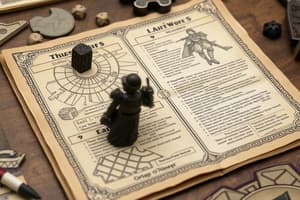Podcast
Questions and Answers
What is Armor Class calculated as?
What is Armor Class calculated as?
- 10 + DEX mod + armor (correct)
- 10 + STR mod + armor
- 5 + DEX mod + armor
- 10 + CON mod + armor
What is the formula for melee weapon attack rolls?
What is the formula for melee weapon attack rolls?
d20 + ProBo + STR
What is the damage formula for ranged weapons?
What is the damage formula for ranged weapons?
DEX
What is the difficulty class for a very easy ability check?
What is the difficulty class for a very easy ability check?
What is the movement cost for climbing, swimming, or crawling?
What is the movement cost for climbing, swimming, or crawling?
What happens when a creature falls?
What happens when a creature falls?
How many rounds can a creature hold its breath?
How many rounds can a creature hold its breath?
How do you stabilize a creature?
How do you stabilize a creature?
A character can attack while prone without any penalty.
A character can attack while prone without any penalty.
What is the attack roll for an unarmed strike?
What is the attack roll for an unarmed strike?
What does it mean to have damage resistance?
What does it mean to have damage resistance?
What is the requirement to cast a spell while wearing armor?
What is the requirement to cast a spell while wearing armor?
What is the function of a concentration spell?
What is the function of a concentration spell?
What is the definition of a critical hit?
What is the definition of a critical hit?
How is spell save DC calculated?
How is spell save DC calculated?
Flashcards
Armor Class (AC)
Armor Class (AC)
A numerical value representing a creature's defensive ability against attacks.
Melee Weapon Attack
Melee Weapon Attack
How to calculate the attack roll for melee weapons (weapons used in close combat).
Ranged Weapon Attack
Ranged Weapon Attack
How to calculate the attack roll for ranged weapons (weapons used at a distance).
Finesse Weapons
Finesse Weapons
Signup and view all the flashcards
Difficulty Class (DC)
Difficulty Class (DC)
Signup and view all the flashcards
Passive Check
Passive Check
Signup and view all the flashcards
Hiding
Hiding
Signup and view all the flashcards
Difficult Terrain
Difficult Terrain
Signup and view all the flashcards
Falling Damage
Falling Damage
Signup and view all the flashcards
Short Rest
Short Rest
Signup and view all the flashcards
Long Rest
Long Rest
Signup and view all the flashcards
Opportunity Attack
Opportunity Attack
Signup and view all the flashcards
Critical Hit
Critical Hit
Signup and view all the flashcards
Damage Resistance
Damage Resistance
Signup and view all the flashcards
Death Saving Throws
Death Saving Throws
Signup and view all the flashcards
Concentration Spells
Concentration Spells
Signup and view all the flashcards
Study Notes
Armor Class
- Calculated as 10 + Dexterity modifier + Armor
Weapon Attack and Damage Mechanics
- Melee Weapons: Attack roll = d20 + Proficiency Bonus + Strength modifier; Damage = Strength modifier
- Ranged Weapons: Attack roll = d20 + Proficiency Bonus + Dexterity modifier; Damage = Dexterity modifier
- Finesse Weapons: Attack roll = d20 + Proficiency Bonus + Dexterity modifier; Damage = Dexterity modifier
- Thrown Weapons: Attack roll = d20 + Proficiency Bonus + Strength modifier; Damage = Strength modifier
Ability Checks and Passive Checks
- Difficulty Classes: Very Easy (5), Easy (10), Medium (15), Hard (20), Very Hard (25), Nigh Impossible (30)
- Passive Checks: Score = 10 + all modifiers, includes Proficiency Bonus if applicable
- Group Check: At least half of skilled characters succeed to allow group success
Stealth and Hiding
- Hiding involves contested Stealth checks against the Perception checks of actively searching creatures and passive perceptions of others
- Lightly Obscured: Disadvantage on perception checks using sight
- Heavily Obscured: Inflicted with the blinded condition
Movement and Terrain
- Difficult Terrain: Costs an extra movement point
- Climbing/Swimming/Crawling: Also costs an extra movement point; may require Athletic checks
Jumping Mechanics
- Long Jump: Distance = Strength score with a 10-foot run-up; check to clear obstacles
- High Jump: Distance = 3 + Strength score with a 10-foot run-up; check to clear obstacles
Falling and Suffocation
- Falling damage: 1d6 bludgeoning per 10 feet (up to 20d6); lands prone unless damage equals 0
- Suffocating: Hold breath for 1 + Constitution modifier minutes, followed by rounds equal to Constitution modifier
Visibility Conditions
- Blindsight: Perceive surroundings without sight, common in certain creatures
- Darkvision: See in dim light as bright and darkness as dim, colorblind in darkness
- Truesight: See through magical darkness and illusions, as well as into the Ethereal Plane
Rest Mechanics
- Short Rest: At least one hour; can use hit dice + Constitution modifier to regain HP
- Long Rest: At least 8 hours, with 6 hours of sleep; interrupted activity can void the rest
Combat Mechanics
- Surprise: Contest Stealth against opposing creature’s passive perception; surprised creatures cannot act on the first turn
- Prone: Can drop prone without using speed; standing up costs half movement
- Opportunity Attack: Reaction attack when a creature moves out of reach
Actions in Combat
- Dash: Doubles movement for the turn
- Disengage: Movement does not provoke opportunity attacks
- Dodge: Attackers have disadvantage; advantage on Dexterity saving throws
- Help: Grants advantage to aided creature on attack before your next turn
- Ready: Delay an action until a specified trigger occurs
Attack Mechanics
- Critical Hit: Roll all relevant dice for the attack twice
- Damage Resistance: Takes half damage from a specific type
- Damage Vulnerability: Takes double damage from a specific type
Death Mechanics
- Instant Death: Remaining damage after reaching 0 HP equals or exceeds maximum HP
- Death Saving Throws: Rolling a d20: 2-9 = fail; 10-19 = succeed; 1 = 2 fails; 20 = stabilizes
- Stabilizing a Creature: DC 10 Medicine check; stable, unconscious creatures regain 1 HP after 1d4 hours
Spell Mechanics
- Prepared Spells: Can be changed after a long rest; requires 1 min per level for each spell
- Rituals: Spells with the "ritual" tag take 10 minutes longer but do not consume a spell slot
- Casting in Armor: Proficiency required to cast spells while wearing armor
- Concentration: Some spells require concentration; taking damage requires a Constitution saving throw
Area of Effect (AoE) Spells
- Cone AoE: Width varies with distance from origin; extends in chosen direction
- Cube AoE: Defined size originating from a point on the cube's face
- Sphere AoE: Radius stretches outward from a central point
Weapon and Armor Proficiencies
- Armor Proficiency: No proficiency leads to disadvantage on all related checks and rolls, and prevents spellcasting
- Weapon Proficiency: Allows use of Proficiency Bonus on attack rolls
Studying That Suits You
Use AI to generate personalized quizzes and flashcards to suit your learning preferences.




